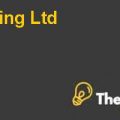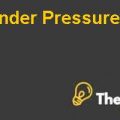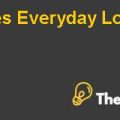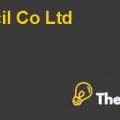
PROBLEM A
A). The decision variable in this problem is the total number of the full time employees and the part time employees that need to be hired in each of the shifts. The objective function of this problem is as follows:
Lets Say,
| F1 | = | Full time employees in shift 1 | 8am-4pm |
| F2 | = | Full time employees in shift 2 | 12am-8pm |
| F3 | = | Full time employees in shift 3 | 4pm-12pm |
| P1 | = | Part time employees in shift 1 | 8am-12am |
| P2 | = | Part time employees in shift 2 | 12am-4pm |
| P3 | = | Part time employees in shift 3 | 4pm-8pm |
| P4 | = | Part time employees in shift 4 | 8pm-12am |
Then,
Minimize Z = 14P1+14P2+14P3+12F1+12F2+12F3+12F4
B).
The complete algebraic form of this problem is as follows:
Minimize Z = 14P1+14P2+14P3+12F1+12F2+12F3+12F4
Subject to,
2F1+4P1>=6
2F1+6P2>=8
2F2+10P3>=12
2F3+4P4>=6
Non-negative Constraints,
F1, F2, F3, P1, P2, P3, P4>= 0
C).
The optimal solution of this problem has been found using the excel solver. The total minimum number of full time employees should be 3, 2 and 7 in shift 1, shift 2 and shift 3 respectively and the total minimum number of the part time employees should be 4,5,8 and 3 in shift 1, shift 2, shift 3 and shift 4 respectively. These are the only optimal number of the employees and the total minimum or the optimal costs if these employees are hired would be $ 408. It cannot be reduced further and it is the optimal cost. Furthermore, it can also be seen that there are at least 2 full time employees for each part time employees. All the decision variables are non-negative.
PROBLEM B
A).
The decision variables in this problem are the number of the shipments from the 4 plants to the 4 retailers. The objective function and the constraints for this problem are as follows:
Minimize Z = 500AA+600AB+400AC+200AD+200BA+900BB+100BC+300BD+300CA+400CB+200CC+100CD+200DA+100DB+300DC+200DD
Subject to,
AA+AB+AC+AD=10
BA+BB+BC+BD=20
CA+CB+CC+CD=20
DA+DB+DC+DD=10
AA+AB+AC+AD<=20
BA+BB+BC+BD<=10
CA+CB+CC+CD<=10
DA+DB+DC+DD<=20
B).
The optimal results have been calculated using the excel solver. It would be optimal to transport 10 shipments from plant 1 to retailer 4, 10 shipments from plant 2 to retailer 1, 10 shipments from plant 2 to retailer 3, 10 shipments from plant 3 to retailer 1, 10 shipments from plant 3 to retailer 4 and 10 shipments from plant 4 to retailer 2. This is going to optimize the transportation problem and the total minimum cost at these numbers of shipments from these specific routes would be $ 10,000.
PROBLEM C
1). Using the sensitivity report in the excel solver, the optimal solution would change if the coefficients of the root beer are changed from $6 to $ 3. This is because, the optimal solution lies in producing root beers and zero orange sodas.
2). The profit would not change if the root beer profit per case is in the range of $6+(1E+30) to $4. Within this range the optimal solution would remain same.
3). The optimal solution would not change if the profit per orange soda case is changed from $5 to $4 because it is within the optimal range of 4-(1E+30) to $6.
4). The additional profit that could be generated by an additional production time would be $(1E+30).
5). The estimated shadow price for the available carbonated water is 1.2. This is the estimated price for this good as there is no market price available for the carbonated water. The shadow price would be valid over the range from 0 to 1500 gallons of carbonated water.OM ASSINMENT Case Solution
TRUE OR FALSE
1. A resource constraint refers to any functional constraint with a ≥ sign in a linear programming model. FALSE
2. For cost-benefit-trade-off problems, minimum acceptable levels for each kind of benefit are prescribed and the objective is to achieve all these benefits with minimum cost. TRUE
3. Generally, assignment problems match people to an equal number of tasks at a minimum cost. TRUE
4. When certain parameters of a model represent managerial policy decisions, what-if analysis provides information about what the impact would be of altering these policy decisions. TRUE
5. When maximizing profit in a linear programming problem, the allowable increase and allowable decrease columns in the sensitivity report make it possible to find the range over
which the profitability does not change. FALSE
6. An optimal solution must lie on the boundary of the feasible region. TRUE
MULTIPLE CHOICE QUESTIONS
1. Sensitive
2. Total shipping cost
3. The slope of the objective function line will always change..................
This is just a sample partial case solution. Please place the order on the website to order your own originally done case solution.












